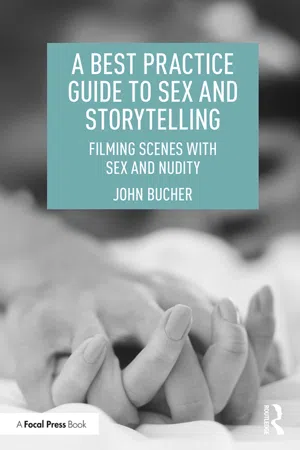![]()
1
A brief history of sexuality and nudity in film and television
Sexuality and nudity have been staples of filmmaking since the beginning. How involved and explicit these scenes are has increased and decreased throughout the decades, with a decided trend toward more openness in terms of intimacy and visions of the human body. While these scenes have often reflected the attitudes and values around sexuality in society, they have also influenced those attitudes and values, as well. One of the most helpful ways to determine what lies ahead for sexuality in media is to take a closer look at its history and how it has developed. When we understand the human factors that have driven the decisions and risks involved in creating what has come before us, we have a better understanding of the potential trends we may see in the future.
1895–1939: The earliest uses of on-screen sexuality
Perhaps the earliest use of moving images to create sensuality was in 1895 at the Chicago World’s Fair, where a cinematic scene of Fatima’s “serpentine dance” was on display. A year later, John C. Rice and May Irwin would exchange the first on-screen kiss, causing Herbert Stone to denounce the cultural moment in the Chicago Tribune. In 1897, Le Tub, by George Méliès, would be lauded as the first “naughty” film. A decade later, the chief of police in Chicago began to require exhibitors to secure permits in order to show films. This, of course, opened the door to the earliest forms of censorship in the medium.1 A significant year for cinematic sexuality and nudity was 1915. In a film called Forfeiture, Fanny Ward’s naked shoulder was seen, stirring the critics. That same year, Annette Kellerman would perform in the first nude sequence in Daughter of the Gods. Clara Bow would continue the trend, appearing nude in Hula in 1917.
In 1922, the burgeoning film industry sought to shutter pro-censorship movements by forming a trade organization, the Motion Picture Producers and Distribution Association, which would self-police its own moral standards. Cultural conservative Will Hays was recruited as the organization’s first president. A long series of attempts by Hays to rein in questionable material would eventually lead to the infamous Hays Code in 1929—a precursor to the modern regulations and rating system endorsed by the Motion Picture Association of America. A wide variety of resources are readily available for those wishing to dig more deeply into the evolving regulatory standards that have been part of the film industry’s self-governing of sex and nudity. 1933’s Ecstasy would feature Hedy Lamar in the first non-pornographic sex act in American film. However, most on-screen sexuality was far more implicit than explicit.
The era would close with new thresholds having been crossed. The industry was beginning to find visual and cinematic language for expressing human sexual experiences. Though the Hays code would limit some exploration, the implicit visuals audiences were seeing on the big screen began to create possibilities in their imaginations of what would be to come in later decades.
Figure 1.1 A scene from Ecstasy
1940–1959: Moving from implicit to explicit
Implicit sexuality in American film would begin to expand in the 1940s with Double Indemnity and The Postman Always Rings Twice, both of which dealt with culpable males and beguiling predatory females who used their sexuality to manipulate.2 The decade would continue with increased erotic tension in films such as Black Narcissus and Rita Hayworth’s Gilda. The 1950s would bring Bitter Rice, A Streetcar Named Desire, One Summer of Happiness, The Moon is Blue, and Billy Wilder’s Some Like It Hot—all of which would continue to push the envelope of implicit sexuality further into the explicit realm.
The first “nudie” film, Russ Meyer’s The Immoral Mr. Teas, closed the decade in 1959 as a sign of the impending freedom that would surround sexual exploration both in culture and in cinema the following decade. Though tame by modern standards, the playful side of sexuality would only continue to become of interest to the culture. While audiences would still crave sex that was romantic and sensual, sex that was fun began to become intriguing as well.
1960–1979: Breaking boundaries
Stanley Kubrick’s Lolita would initiate the 1960s into cinematic sexuality. Black actress Thelma Oliver revealed her breasts in 1965’s The Pawnbroker, opening the door for other actors to soon follow suit. Two years later, female genitalia would be seen in Blow Up, and again the next year in If. Interracial sexuality would be surveyed in 1968 with 100 Rifles. Male genitalia would become trendy in 1969 with More and Cherry, Harry and Raquel. Midnight Cowboy would open up conversations about gay relationships in a mainstream film, becoming the first, and only, X‑rated film to win the Best Picture Oscar the next year.
The 1960s would also open up sexual standards on television, which had been a far more conservative medium, when the show Bewitched featured a married couple sharing the same bed. Before this milestone, couples were always explicitly seen in separate beds on TV. Raquel Welch would appear as a transsexual in 1970s Myra Breckenridge, and Last Tango in Paris would further push the boundaries for what was shown in large-scale commercial releases. Explicit sexuality was thrust into the forefront of the cultural conversation in 1974 with the release of Emmanuelle and Gerard Damiano’s The Devil in Miss Jones. Deep Throat would only amplify the conversation the following year. Despite these earlier cinematic successes, a noted line was drawn between the explicit visuals of pornographic films and dramatic films with erotic content. Theatrical chains would decidedly begin to limit what acts could be seen in detail and what must be confined to implicit suggestion.
1980–1999: Expanding sexualities
On-screen sexuality was not giving up exploration completely, however. The 1980s would bring 9½ Weeks, which explored masturbation, exhibitionism, cross-dressing, threesomes, and bondage in mainstream film, as well as teen sex comedies such as Porky’s. The decade would also give rise to the erotic thriller, most notably Fatal Attraction, which would gain momentum into the 1990s with Basic Instinct. The Crying Game would explore gender transcendence in an unambiguous scene that shocked many audiences at the time, and Henry and June would become the first major release to receive an NC-17 rating for explicit sexuality. Television would also relax its standards in the 1990s with innuendo and nudity on shows such as NYPD Blue and the first lesbian couple having sex on Buffy the Vampire Slayer. The year 2001 would be an important one for sexuality in cinema, both in the United States and abroad. David Lynch’s Mullholland Drive would feature lesbian sex between two mainstream actresses, and Intimacy would offer more than 35 minutes of on-screen explicit sex, including a brief scene of the lead actor fellating her co-star—a first in mainstream cinema. That same year, Y Tu Mamá También would explore a sexual relationship among three people. Brokeback Mountain would break new ground as a major release about two cowboys in love, offering open sexuality between the two lead actors.
Figure 1.2 A scene from 9 1/2 Weeks
2000 and beyond
Cable television would expand what was seen by the public throughout the 2000s with shows such as Oz, Sex and the City, Queer as Folk, and The L Word. Unsimulated sex in films such as Shortbus saw commercial release in some cineplexes, while sexual themes and acts in line with the culture’s changing values and standards continued to make their way into film and television. The rise of online and streaming content transcended traditional standards that had been imposed on historical mediums, though most major online outlets chose to adhere to the criteria established by cable television, despite a lack of regulation. Most recently, The Deuce, Game of Thrones, Girls, Transparent, and Insecure have all been discussed as programs that are surpassing what has been traditionally shown in non-pornographic programming.
Figure 1.3 scene from Netflix’s Sense8
The post-Weinstein era
The discussion around on-screen sexuality and nudity in the industry, particularly from A-list talent, continues to be a subject of debate for many in the post-Weinstein era, especially among those who had been victims of harassment. Many celebrities have had nude photos hacked from private cell phones and made publicly available, complicating their nude appearances in film and television. Jennifer Lawrence asked fans not to view her nude photos that were leaked via the Internet in 2014, sparking an important conversation about the role of consent in the public consumption of nudity. Consent has been further explored as even some celebrities that agreed to appear nude would later say they felt pressured by industry powerbrokers, in order to keep seeing career advancement.
In 2018, Lawrence decided to appear nude in the film Red Sparrow and was asked about her experience in light of the nude photos that had been released earlier. Her response:
The insecurity and fear of being judged for getting nude, what I went through, should that dictate decisions I make for the rest of my life? This movie changed that and I didn’t even realize how important changing that mentality was until it was done.3
She went on to discuss the importance of the on-set experience in her change in mentality:
We talked about it [with the director, Francis Lawrence] extensively, which was really important for showing up on the day and there being no surprises. I knew exactly what was going on and also there was one moment he came out to give me a note and just looked at me like I had clothes, and then I just felt like I had clothes on. I was surrounded by professionals and everybody was completely professional.4
Other celebrities who have been victims of harassment have chosen to no longer appear nude in film or television.
Stabilized standards and online impact
The expansion of standards dealing with what bounds exist around film ratings in the United States and the United Kingdom have flat-lined in recent years. As a wider range of sexual expression and explicit content has become more available to the general public through the Internet, the cultural “pressure” to see these horizons expand in the world of cinema has perhaps lessened, as well. Internet pornography has impacted the role of sexuality and nudity in film and television, though the effects and details of this impact are still greatly being sorted out. In many ways, the artistic intent ideally found in cinematic expressions around sexuality has become more needed and significant than ever, as art has a way of opening up a subject to our understanding beyond simply the words we would ascribe to it. Understanding how to maneuver scenes of sexuality in order to craft such scenes is now more necessary than ever if the artistic exploration of sexuality is to be differentiated from content with pornographic intent.
Notes



